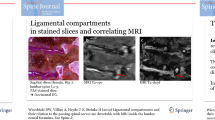Abstract
Vertebral bone, joints and ligaments on the cervical spine are structures that maintain the stability of the spine and protect the neurovascular structures. Determining the detailed anatomical location of the intervertebral foramen and unco-vertebral (UV) region with respect to the vertebral bone, joint and ligaments is critical when choosing the safest surgical approach to the cervical spine. We studied the microscopic detailed anatomy of the dural covering and posterior longitudinal ligament (PLL) in eight cadaver specimens and the relevance of these structures in the UV region from C4 to C7. The uncinate process (UP) and its covering ligaments are mechanical barriers that prevent the nerve root and the vertebral artery against unintentional surgical damage. Dissection at the posterolateral surface of the UP revealed a separate perivascular fibroligamentous tissue (PVFLT) that originates from the PLL. The recognition of the PVFLT may provide for safe surgery by protecting the neural and vascular structures during decompression in the UV region. The French version of this article is available in the form of electronic supplementary material and can be obtained by using the Springer Link server located at http://dx.doi.org/10.1007/s00276-002-0087-5.
Résumé
L'os vertébral, les articulations et les ligaments de la colonne cervicale sont des structures qui maintiennent la stabilité de la colonne vertébrale et protègent les structures neuro-vasculaires. La reconnaissance de la localisation anatomique détaillée du foramen intervertébral et de la région unco-vertébrale, en fonction de l'os vertébral, de l'articulation et des ligaments, est délicate lorsque l'on choisit une voie chirurgicale sûre pour la colonne cervicale. Nous avons étudié l'anatomie microscopique détaillée de la couverture durale et du ligament longitudinal postérieur sur huit cadavres. L'aspect de ces structures dans la région unco-vertébrale a été étudié de C4 à C7. Le processus uncinatus ou uncus et ses ligaments qui le recouvrent sont des barrières naturelles qui préviennent la racine nerveuse et l'artère vertébrale d'une lésion chirurgicale non intentionnelle. La dissection de la surface postéro-latérale de l'uncus révèle un tissu fibro-ligamentaire péri-vasculaire distinct (PVFLT) qui prend son origine du ligament longitudinal postérieur (LLP). L'identification du PVFLT permet une chirurgie sûre en protégeant les structures neurologiques et vasculaires pendant la décompression de la région unco-vertébrale.



Similar content being viewed by others
References
Chaynes P, Verdie JC, Moscovici J, Zadeh J, Vaysse P, Becue J (1998) Microsurgical anatomy of the internal vertebral venous plexuses. Surg Radiol Anat 20: 47–51
Chesnut RM, Abitbol JJ, Garfin SR (1992) Surgical management of cervical radiculopathy. Indication, techniques and results. Orthop Clin North Am 23: 461–474
Citow JS, McDonald RL (1999) Posterior decompression of the vertebral artery narrowed by cervical osteophyte: case report. Surg Neurol 51: 495–498; discussion 498–499
Cloward RB (1958) The anterior approach for removal of ruptured cervical discs. J Neurosurg 15: 602–614
Ebraheim NA, Lu J, Brown JA, Biyani A, Yeasting RA (1996) Vulnerability of vertebral artery in anterolateral decompression. Clin Orthop 322: 146–151
George B, Gauthier N, Lot G (1999) Multisegmental cervical spondylotic myelopathy and radiculopathy treated by multilevel oblique corpectomies without fusion. Neurosurgery 44: 81–90
Grundy PL, Germen TJ, Gill SS (2000) Transpedicular approaches to cervical uncovertebral osteophytes causing radiculopathy. J Neurosurg (Spine 1) 93: 21–27
Hakuba A (1976) Trans-unco-discal approach. A combined anterior and lateral approach to cervical discs. J Neurosurg 45: 284–291
Hayashi K, Yabuki T, Kurokawa T, Seki H, Hogaki M, Minoura S (1977). The anterior and the posterior longitudinal ligaments of the lower cervical spine. J Anat 124: 633–636
Isu T, Minoshima S, Mabuchi S (1997) Anterior decompression and fusion using bone grafts obtained from cervical vertebral bodies for ossification of the posterior longitudinal ligament of the cervical spine: technical note. Neurosurgery 40: 866–869; discussion 869–870
Jho HD (1996) Microsurgical anterior cervical foraminotomy for radiculopathy: a new approach to cervical disc herniation. J Neurosurg 84: 155–160
Klein GR, Ludwig SC, Vaccaro AR, Rushton SA, Lazar RD, Albert TJ (1999) The efficacy of using an image-guided Kerrison punch in performing an anterior cervical foraminotomy. An anatomic analysis. Spine 24: 1358–1362
Kojima T, Waga S, Kubo Y, Kanamaru K, Shimosaka S, Shimizu T (1989) Anterior cervical vertebrectomy and interbody fusion for multi-level spondylosis and ossification of the posterior longitudinal ligament. Neurosurgery 24: 864–872
Koyama T, Handa J (1985) Cervical laminoplasty using apatite beads as implants. Experiences in 31 patients with compressive myelopathy due to developmental canal stenosis. Surg Neurol 24: 663–667
Kubo Y, Waga S, Kojima T, Matsubara T, Kuga Y, Nakagawa Y (1994) Microsurgical anatomy of the lower cervical spine and cord. Neurosurgery 34: 895–890; discussion 901–902
Kumar GR, Maurice-Williams RS, Bradford R (1998) Cervical foraminotomy: an effective treatment for cervical spondylotic radiculopathy. Br J Neurosurg 12: 563–568
Nagashima C (1970) Surgical treatment of vertebral artery insufficiency caused by cervical spondylosis. J Neurosurg 32: 512–521
Oh SH, Perin NI, Cooper PR (1996) Quantitative three-dimensional anatomy of the subaxial cervical spine: implication for anterior spinal surgery. Neurosurgery 38: 1139–1144
Pait TG, Killefer JA, Arnautovic KI (1996) Surgical anatomy of the anterior cervical spine: the disc space, vertebral artery, and associated bony structures. Neurosurgery 39: 769–776
Vaccaro AR, Ring D, Scuderi G, Garfin SR (1994) Vertebral artery location in relation to the vertebral body as determined by two-dimensional computed tomography evaluation. Spine19: 2637–2641
Author information
Authors and Affiliations
Corresponding author
Additional information
The French version of this article is available in the form of electronic supplementary material and can be obtained by using the Springer Link server located at http://dx.doi.org/10.1007/s00276-002-0087-5
Rights and permissions
About this article
Cite this article
Yilmazlar, S., Ikiz, I., Kocaeli, H. et al. Details of fibroligamentous structures in the cervical unco-vertebral region: an obscure corner. Surg Radiol Anat 25, 50–53 (2003). https://doi.org/10.1007/s00276-002-0087-5
Received:
Accepted:
Published:
Issue Date:
DOI: https://doi.org/10.1007/s00276-002-0087-5




